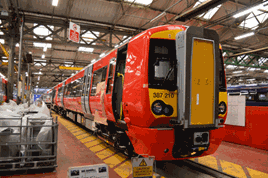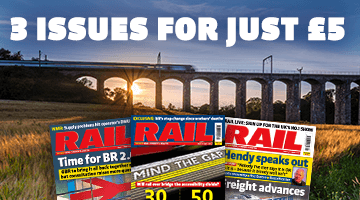Elsewhere in London, as mentioned earlier, London Overground (LO) introduced 57 new carriages onto its network by extending the Class 378 fleet from four to five-car formations. The final five vehicles were delivered to LO on December 2 (RAIL 790), and were ordered as part of the London Overground Capacity Improvement (LOCIP) and Rolling Stock Programmes (LOTRAIN) scheme.
This delivered five-car trains to the East London Line (ELL) by December last year and to the North London Line (NLL) by December 2015. The £88m deal was placed with Bombardier in May 2013, and was part of an option placed in the original order agreement that increases capacity on LO by 25%. The final five vehicles delivered were 38433/434/455-457. They will be inserted into 378233/234/255-257.
The first to be extended were 378135-154, which can only work on ELL or DC lines to Watford, while the ‘378/2s’ are capable of working on ELL, NLL, South London Line (SLL), West London Line (WLL) and DC Lines to Watford. This was not the first time some of the trains had been extended: 378001-378024 were delivered as three-car EMUs in 2009 with the plan always being to extend them to four-car trains, a move that was completed quickly.
Also in the capital, 29 four-car Class 387/1s (116 vehicles) were delivered to Govia Thameslink Railway (GTR) for the Thameslink route. The last entered traffic in May 2015 and also allowed GTR to cascade Class 319/3s to the North as well as four Class 319s to London Midland. The ‘387/1s’ will not be a long-term option for TL as they will be replaced by the Siemens Class 700s, and so will be transferred to GWR – although whether they will be used straightaway is open to conjecture at the moment due to the delays in electrifying the Great Western Main Line (GWML).
Locomotives are not included in the RDG figures. This means that Colas Rail’s 70801-70810, GB Railfreight’s (GBRF’s) purchase of 66752-66779 and Direct Rail Services’ Class 68 and 88 fleets are not included.
The Class 70s were ordered off the back of major National Supply Chain contract wins for Colas Rail, which has established itself as a significant player in the rail freight market. The haulage capability of the ‘70s’ means the company can bid for heavy haul work, and has been doing so.
GBRf has bought the final Class 66s that can be built for the UK, with delivery of the final batch from America due in early-2016. Any more that are needed (and GBRf has a history of expanding and importing ‘66s’ from Europe) will have to be second-hand.
As with all ‘66’ orders, they have been delivered in batches, with 66752-66756 the first to arrive on these shores in the summer of 2014, followed by 66757-66765 and then 66767-66772 at the end of last year. They will be joined by 66773-66779, bringing down the curtain on a design that first arrived here in 1998.
Since EWS 66001 arrived in April that year, a further 484 Class 66s have been delivered (although not all are in the UK) and following severe accidents, two have been scrapped (66521 following the Great Heck crash in February 2001, and 66734 after it went down a bank in the West Highlands in 2013).
DRS’ order of the Eurolight offered by Vossloh has enabled it to enter the passenger market while also offering powerful locomotives for freight work. So far 19 Class 68s have been delivered to the Cumbrian company. Of those 19, two are hired to ScotRail on a daily basis and six to Chiltern Railways for passenger work. It cannot be ruled out that more could be hired by operators in the future.
The real game-changer could be the Class 88. This is an electric locomotive fitted with a diesel engine. Similar in design to a Class 68, and also built by Vossloh, the Class 88s could prove invaluable in being able to operate ‘under the wires’ and also in terminals away from overhead line electrification. Network Rail is excited by the possibility, as is DRS, as you would expect. What it can offer the freight industry remains to be seen, but it could represent a significant evolution in operations.
There have been many changes in the last decade or so. Bi-mode is an option that offers greater flexibility for the likes of GWR, TPE and Virgin Trains East Coast. Greater capacity is being offered to operators in places it is needed, and even where new trains are not being delivered, cascaded trains are available to offer a step-change in service quality, as witnessed in the North West where trains operated by two-car Pacers have been transformed into four-car electric multiple units.
The next four years promises much in the train fleet market, with benefits to passengers and freight customers alike.
- This feature was published in RAIL 791 on January 6 2016
















Login to comment
Comments
No comments have been made yet.